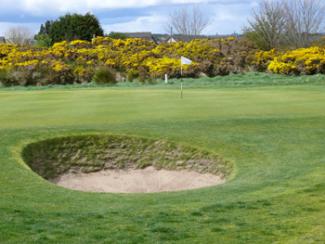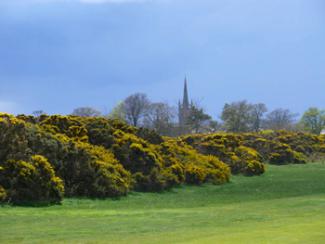Featured Golf News
Crossing Scotland, Day 3 - Unearthing a Gem
We headed out of St. Andrews, up the coast toward Carnoustie, famous as the most difficult of the regular collection of courses for the British Open. Even though there are pictures of past Open winners at Carnoustie - players like Ben Hogan and Tom Watson - it has none of the mystique or magic of St. Andrews.

The Gorse is Close to the Greens at Montrose
It's just a tough, tough golf course.
We weren't trophy-hunting for another Open site. We wanted to get closer to the grassroots of Scottish golf, and continued up the coast to Montrose, where they've played golf under varying conditions since 1562. By almost any account, Montrose is the fifth-oldest course in golf.
It proved to be our first discovery of a so-called hidden gem, but in this case it was not so-called. The two courses at Montrose hug the North Sea but are most distinguished by the heavy rows of flowering gorse that borders most fairways, making this course demanding off the tee and thus worthy of hosting qualifying for previous Open championships, which it did in 1999 and 2007.
But to best understand how important golf is in the lives of most Scots, the two golf courses at Montrose have almost 1,000 members from a town of about 12,000 people.

The Famed Steeple in Montrose Looms
over the Local Golf Club
For drop-ins like us, the charge for 18 holes on the medal course is 55 pounds, or about $85. For the members - who get unlimited golf on the two courses - the annual charge is closer to $500. Do the math. The Scots have figured out that it is better to have a strong local following - and dependable income - than being reliant on over-the-counter business.
Right across the street from the small, unpretentious pro shack at Montrose are the "clubs" of Montrose: Caldonia, Royal and Mercantile. Each has their own clubhouse and, besides having a golf membership at Montrose, they carry on various social activities. You'd have to think most important decisions in these parts of the country have been made in one of the clubs.
Ben Crenshaw once called Montrose a "magnificent stretch of marvelously natural ground which depicts how the game was born."

A Threesome Enjoys a Drink outside the Mercantile Club
The fairways are generous as they are on most links courses, but miss one and you might be in the gorse, which is surely a lost ball. But this place is so authentic. There are no carts or cart paths to be seen. Tees are right next to greens, so the walk is reasonable.
The first few holes butt right up against the North Sea. The fairways are lumpy - built before there was land-moving equipment - but they're also firm and very fast.
I could imagine how many Scots before me had played these holes.
Blaine Newnham has covered golf for 50 years. He still cherishes the memory of following Ben Hogan for 18 holes during the first round of the 1966 U.S. Open at the Olympic Club in San Francisco. He worked then for the Oakland Tribune, where he covered the Oakland Raiders during the first three seasons of head coach John Madden. Blaine moved on to Eugene, Ore., in 1971 as sports editor and columnist, covering the 1972 Olympic Games in Munich. He covered five Olympics all together - Mexico City, Munich, Los Angeles, Seoul, and Athens - before retiring in early 2005 from the Seattle Times. He covered his first Masters in 1987 when Larry Mize chipped in to beat Greg Norman, and his last in 2005 when Tiger Woods chip dramatically teetered on the lip at No. 16 and rolled in. He saw Woods' four straight major wins in 2000 and 2001, and Payne Stewart's par putt to win the U.S. Open at Pinehurst. In 2005, Blaine received the Northwest Golf Media Association's Distinguished Service Award. He and his wife, Joanna, live in Indianola, Wash., where the Dungeness crabs outnumber the people.
Story Options
 |
Print this Story |
